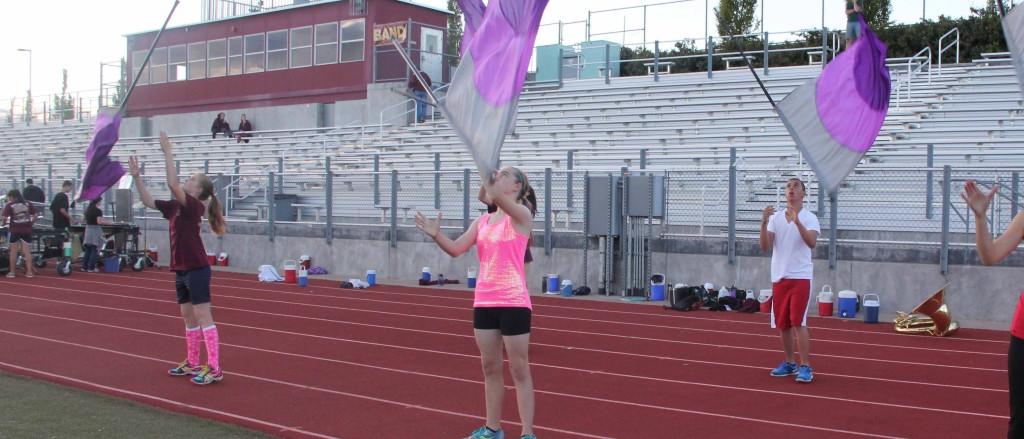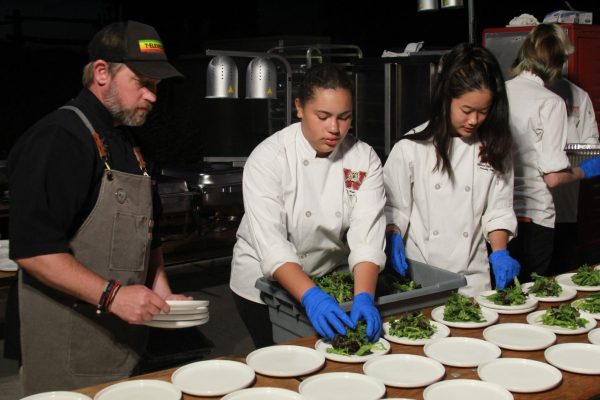Color guard waves their flags on the football field
Color guard practices their routine on Sept. 26. Photo by RILEY WYNNE
It was the start of freshman year when Vicky Burton walked into the black gates of this campus, overwhelmed by rows and rows of tables at orientation. She walked around anxiously, searching for an activity to set her heart on. Then, she walked past a booth that would take charge of her high school years: the color guard booth.
“It was the best decision to give out my email [address] in my life,” Burton said.
Color guard is the visual aspect of the marching band. Most know them as the ones who twirl the large flags on the field at football games, which is correct. However, there is so much more to color guard. The practices, the routines, the competitions, and completing the awe striking performance of the marching band with their gleaming flag colors and routines.
“Color guard is where a bunch of people spin flags, rifles and sabers to add to the visual aspect of the marching band. It takes a lot of focus; if you mentally lapse, you could mess up. It also takes commitment,” Burton said.
Burton is now captain for her junior year. She is responsible for scheduling informal meetings, keeping the guard on task, leading stretches and routines and communicating with the band director Mr. Kris Harper.
“Color guard is the visual portion of what the marching band does, it’s in the name really. They present the Color for all the audio that the band produces on the field,” Harper said.
Color guard isn’t just a sight to see at the football field. At marching band competitions, they perform with the band and are judged, ranked, and compete against all the other marching bands who perform at the competition. Their next competition is Nov. 2nd in Folsom.
“Not only does Color Guard get judged as a section of the band, they also get judged as a Color guard to specific judges, who are just judging what the color guard does,” Harper said.
Color guard members also must work on their routines for the competitions. After their routines are perfected, they have to add those routines to the drill, making the necessary changes needed to make sure that no marching band members are whacked off of balance and fall flat on their face in the middle of a performance.
“It was really really hard at first, but it got easier. Just takes practice,” Michael Agaiby said.
Agaiby is a rookie in color guard, who started this year after a friend told him about the sport. His first performance was the Quarry Bowl.
“Quarry Bowl was really nerve racking, because there was like one million people there!” Agaiby said.
Though he has to work hard to perfect his drills, the more he works, the better he gets. He and Burton recommend color guard to any students interested in the sport.
“It’s an amazingly fun activity; come try it out during one of our clinics. I guarantee you won’t be disappointed,” Burton said.
The band is always accepting more students who are interested in color guard.
“We want the band to get bigger and bigger every year. We’d love to have about 20 color guard [members]; that’s our big push it trying to get people interested,” Harper said.
by RACHEL MARQUARDT



![On the stage, Daniel Bozinovski and Rachel Treto play their part as Tom and Hannah in the show “The Cast List”. The show was about a group of students who were told about their cast list for the play “Romeo and Juliet.” The Theater I students were in preparation for their first showcase of the year. Students went over their lines during all of their class for the past two months. “[We put in] a lot of rehearsal, practicing lines, making sure you have everything memorized and making sure you are ready to go in and not forget anything,” Nathan Weeks said. Photo by Megan Kubas.](https://www.whitneyupdate.com/wp-content/uploads/2024/05/IMG_4085-600x396.jpg)





